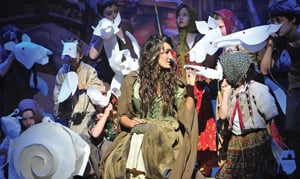Making the most of friendship
Gemma Taylor explains how to make friends with your attenders

More than ever in the current climate, cultural organisations have to rely on their audiences and visitors to fund not only capital and refurbishment projects but also ongoing running costs. There is much discussion in the sector at present regarding the best way to engage supporters in to giving funds on a regular basis. The biggest debate of all is between friends’ schemes with benefits and requests for purely philanthropic support. Do you need to give people tangible return for their donation, or are they ways to encourage them to support you without needing to give them something in return?
Capital appeals have, on the whole, been successful. This is due to the changes that can be viewed by your supporters. ‘Name a Seat’ appeals encourage larger donations and corporate support, due to the lasting recognition that accompanies the gift. The challenge is how to gain support without having to offer anything in return, as well as securing donations on a monthly basis even when there is no grand project to talk about.
CULTIVATING RELATIONSHIPS
Fundraising requires a deep understanding of, and respect for, your audience and visitors. It is a long-term activity, and respect and loyalty must form the building blocks. More attention needs to be paid to audiences, firstly because they have the money and secondly because they are a vital part of any cultural organisation – theatres, museums and galleries can’t exist just for the benefit of the artists and promoters, there must be a social purpose too. You will need money next year and in every year, therefore any audience initiatives you put in place now will continue to yield results – if you plan and manage them well. You must think in terms of investment not just in terms of annual budgets.
To get an understanding of your audiences you need a database which charts ticketing transactions. It is not a coincidence that in countries which have lower public subsidy for culture these systems are very common and the use of ticketing agencies is much lower. Based on this information, you can start to build up a picture of your attenders, and formulate ways to integrate them into your fundraising plans. Most databases also have the capacity to help build and manage loyalty schemes. Are you gathering all the information possible? Does your box office ask for email addresses and dates of birth for example?
WHO, WHAT, WHERE, WHEN AND WHY
The challenge is to identify those people who are attending on a regular basis and what they enjoy. Are they only attending jazz performances? Are they purchasing just for classical music and opera, or is dance their draw? Until you know why people attend your venue or events, it is impossible to communicate effectively about why you need their support.
The aim is to get these supporters to develop greater loyalty and give financial support without the need for benefits, which could end up with the organisation paying out more for the benefits than the annual cost of the membership. With the media coverage of cuts, the general public is more aware that not-for-profit organisations have to pick up where government and public funding has left off. There are a number of approaches that you can take to raise awareness of what any cut in subsidy would mean to your organisation.
How much ticket prices would need to rise by is verging on scaremongering and is not the best way to inspire people to give to you on a long-term basis. A more positive approach, which feeds on the need to see something tangible in return (as with a capital appeal), is breaking down the running costs into something very visible – the cost of ballet shoes, wigs, costumes and so on. Inspiration is the key to a successful appeal for friends – and if that inspiration can be built on and developed, then you will secure long-term loyalty (and revenue) without the need to offer anything in return apart from the warm feeling and the sense of pride. This is particularly effective for regional venues and organisations, where people can really feel they are contributing to the local community. An example is the Oxford Playhouse, where 60% of donors who started giving in 1992 are still giving today. This shows that with the right approach and cultivation nearly two decades of funding can be secured from individuals.
In conclusion, audiences and visitors have a long-term value to your organisation which is expressed in both financial and non-financial terms. Building a relationship with everyone who steps through your door is vital. It is important that you understand them in order to effectively inspire them and generate a regular flow of income from them. Your understanding of them will then need to be used to find ways of retaining your audiences once you have established your relationship with them. Think about your own personal friends and how they became friends in the first place. The same principles apply on an organisational level. They have come through your doors, don’t lose them.
Join the Discussion
You must be logged in to post a comment.